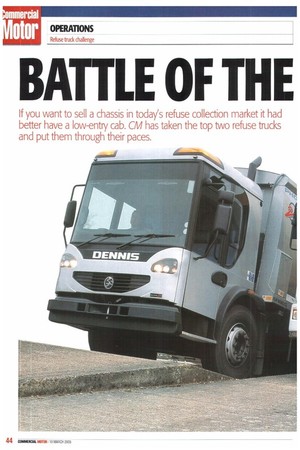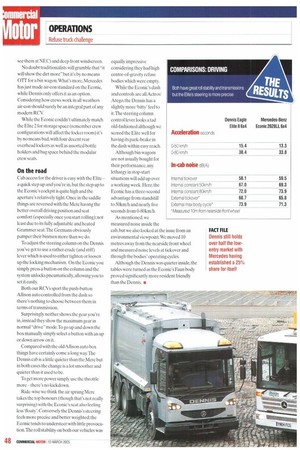BATTLE OF THE NIVIEN
Page 44

Page 45

Page 46

Page 47

Page 48

If you've noticed an error in this article please click here to report it so we can fix it.
If you want to sell a chassis in today's refuse collection market it had better have a low-entry cab. CM has taken the top two refuse trucks and put them through their paces.
Ne suppose you can blame it all on Dennis.The UK specialist chassis manufacturer was at the forefront of the low-entry refuse collection vehicle (RCV) revolution, and where one leads others surely follow.The most significant 'other', of course, being Mercedes-Benz with the stylish Econic it launched in 1999.
Based on recent SMMT bodybuilder statistics, while Dennis holds over half the lowentry market (it finished 2004 with an astonishing 55%), Mercedes has leapfrogged over Seddon into second place in what can only be described as a pretty spectacular turnaround, Five years ago Mercedes had just 6% of the low-entry RCV market while Seddon Atkinson held 41 %.Today the Econic has given Mere a 25% stake while Seddon's Euromover/Pacer line-up can only muster 20%. How the mighty are fallen.
More importantly, half of all the Econics built at Merc's Worth main assembly plant end up over here.
Make no mistake, the low-entry share of the two and three-axle RCV chassis market is growing inexorably— some pundits expect it to hit 80% this year.
Overall RCV sales have also been doing well.Although the 2004 figure of 1,749 was somewhat down on the 1,839 sold in 2003, the trend since the turn of the century has definitely been /1 upwards. The steady growth 11111' in 26-tonne GVW three-axle RCVs (complete with sophisticated on-board weighing systems) has been fuelled by operators keen to avoid the wrath of VOSA and their local Traffic Commissioner following a number of high-profile overloading cases. However, with a typical load now as likely to end up at a transfer station as a landfill site, interest in fullblown 6x4s is waning in favour of 6x2s.
But back to low-entry cabs. If you expect to sell an RCV in the UK you've got to have one in your model line-up, and it had better be purpose built.rather than some ad-hoc adaptation of a standard chassis.
To compare the top two contenders we held our own RCV shoot-out between the latest Dennis Elite 2 and the Mere Econic at the Oinetiq test track in Surrey.
Contenders From its neat integral beacons and easy-toreplace headlights to its voluminous crew cab, the Dennis Elite 2 is the classic example of a truck that's "fit-for-purpose". Launched in 2003, it's available in 4x2.6x2 (mid-lift/midsteer/rear-steer) and 6x4 versions.
Power is courtesy of a 5.9-litre Euro-3 Cummins ISBe six-pot pushing out either 250hp or, as in the case of our test truck,275hp, with 934Nm of torque.
Behind the baby Cummins sits anAllison five or six-speed World-Series auto box (our 6x4 had the six-speed). Power is fed to the road (or landfill site) via a Dana double-drive bogie with rubber suspension as standard.The standard chassis is 2.5m wide and there's a 2.2m version for tight operating conditions.
The Elite 2's stainless steel and composite cab is built at the old Duple site at Blackpool (now part of the Dennis Eagle empire) before being shipped down to the company's main assembly plant at Warwick.The same Elite 2 cab is supplied under licence to MAN which will offer it on a re-badged TGA chassis.
Nestling on the back of our Elite 2 chassis was a 22m3 Phoenix 2 body with Beta 2 bin-lifting gear courtesy,inevitably,of Dennis Eagle. However, half of Dennis chassis carry thirdparty bodies, and the same proportion of Dennis bodies end up on other makes of chassis.
By way of contrast, the Mercedes-Benz Econic is available as a 4x2, 6x2 (mid or rearsteer) or, in the case of our model, as the 2628LL 6x4. Power is provided by the 279hp 6.37-litre 0M906LA six-pot used in the Atego range; it pum ps out 1,100Nm of torque which is a little more than the Dennis. RCV operators looking for more power can have the 330hp option based on the stroked 7.2-litre 0M926LA lump.
Behind it you'll find the same AllisonWTMD3060P auto as the Elite 2, albeit with one ratio electronically blanked off.
What marks the Econic out from its rivals is its disc brakes and air suspension.
The tall Merc cab has an aluminium and composite construction and a hinged scissortype door for the crew.The business end on our Econic is a Faun 22m1Variopress body but it's by no means unusual to see an Econic fitted with a body from Geesink. Heil — or even Dennis-Eagle.
As they are likely to operate off-road both our RCVs come with comfortingly stout engine and transmission shields; the Econic's ride height can be raised by 40nun via its air suspension to boost ground clearance. Mere is obviously determined to offer a high spec on the Econic; a CD/radio and axle load indicator are to be fitted as standard.
Cab qualities
From a crewman's perspective, access to the Dennis is slightly better than the Econic thanks to its slightly lower first step (460mm vs 555mm).
The Elite 2's conventional opening door also provides a slightly (175mm) wider aperture than the Econic's scissor door. On the other hand you can park an Econic close to a lamppost or bollard and not have to worry about clobbering the kerbside door.
Dennis does offer a scissor door on the MAN/export cab but says it doesn't get asked for it. Whatever your door preference both vehicles comfortably exemplify the superior ease of entry provided by low cabs.
The interior set-up on our Elite 2 was for a driver and crew of three on a bench seat (a driver-plus-five version is available).With a flatter dash the Dennis provides slightly better cross-cab access; its bench seat is also longer than the Econic's three-man modular seating unit —by all of 20mm —but the Econic has more headroom.
Where the all-British contender really shines is with its storage layout, in particular the deep bins on the rear cab wall (in place of a second row of seats). Dennis had fitted our test truck with the optional (i850) locking roller shutters on the bins which will protect the crew's belongings from opportunist jump-up' toe-rags.
There's plenty more stowage space under and behind the crew bench seat. in the rearwall top pod, and well as in the headlining (where you can also easily access the integral flashing beacons to replace a blown bulb). Behind the driver's seat there's a neat holder for wipes and emergency eyewash, plenty of coat hooks too and a couple of cup-holders.
Where the Elite does tend to lose out is the finish of its cab interior, which can't quite match that of a 'mainstream' manufacturer. The rather spartan dash and dark interior trim materials are certainly well suited to the RCV role, even if they are drawn from the 'form follows function' school of design.
The blue seat cover on the bench seat is fully washable vinyl while the driver's seat has a cloth insert on the base.
An in-cab makeover wouldn't go amiss, but without losing the Elite's practical roots.
By contrast with the Econic you enter a far brighter, airier environment, not least thanks to the latest background trim materials launched at last year's Hanover Show (we'll see them at NEC) and deep front windscreen.
No doubt traditionalists will grumble that -it will show the dirt more" but it's by no means OTT for a bin wagon, What's more. Mercedes has just made air-con standard on the Econic, while Dennis only offers it as an option. Considering how crews work in all weathers air-con should surely be an integral part of any modern RCV.
While the Econic couldn't ultimately match the Elite 2 for storage space (remember crew configurations will affect the locker room) it's by no means bad, with four decent rear overhead lockers as well as assorted bottle holders and bag space behind the modular crew seats.
On the road
Cab access for the driver is easy with the Elite — a quick step up and you're in, but the step up to the Econic's cockpit is quite high and the aperture's relatively tight. Once in the saddle things are reversed with the Mere having the better overall driving position and seat comfort (especially once you start rolling); not least due to its fully adjustable and heated Grammer seat.The Germans obviously pamper their binmen more than we do.
To adjust the steering column on the Dennis you've got to use a rather crude (and stiff) lever which is used to either tighten or loosen up the locking mechanism. On the Econic you simply press a button on the column and the system unlocks pneumatically, allowing you to set it easily.
Both our RCVs sport the push-button Allison auto controlled from the dash so there's nothing to choose between them in terms of transmission.
Surprisingly neither shows the gear you're in, instead they show the maximum gear in normal -drivemode, To go up and down the box manually simply select a button with an up or down arrow on it.
Compared with the old Allison auto box things have certainly come a long way.The Dennis cab is a little quieter than the Merc but in both cases the change is a lot smoother and quieter than it used to be.
To get more power simply use the throttle more — there's no kickdown.
Ride-wise we think the air sprung Mere takes the top honours (though that's not really surprising) with the Econic's seat also feeling less 'floaty'. Conversely the Dennis's steering feels more precise and better weighted; the Econic tends to understeer with little provocation.The roll stability on both our vehicles was equally impressive considering they had high centre-of-gravity refuse bodies which were empty.
While the Econic's dash and controls are all Actros/ Atego,the Dennis has a slightly more 'bitty' feel to it.The steering column control lever looks a tad old-fashioned although we scored the Elite well for having its park-brake in the dash within easy reach.
Although bin wagons are not usually bought for their performance, any lethargy in stop-start situations will add up over a working week. Here. the Econic has a three-second advantage from standstill to 50km/h and nearly five seconds from 0-80Iun/h.
As mentioned, we measured noise inside the cab, but we also looked at the issue from an environmental viewpoint.We moved 10 metres away from the nearside front wheel and measured noise levels at tickover and through the bodies' operating cycles.
Although the Dennis was quieter inside, the tables were turned as the Econic's Faun body proved significantly more resident friendly than the Dennis. •










































































































































































































